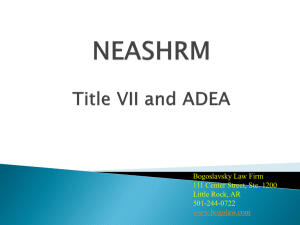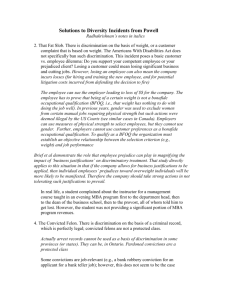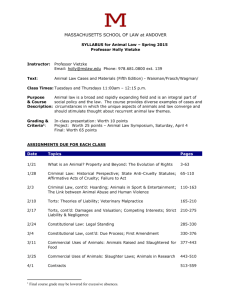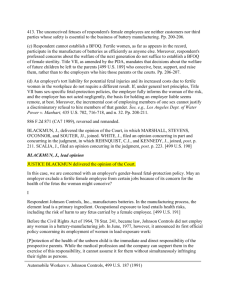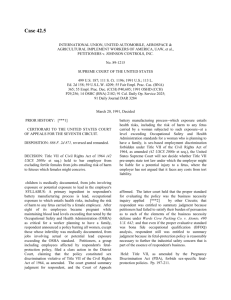Employment_Law_II
advertisement
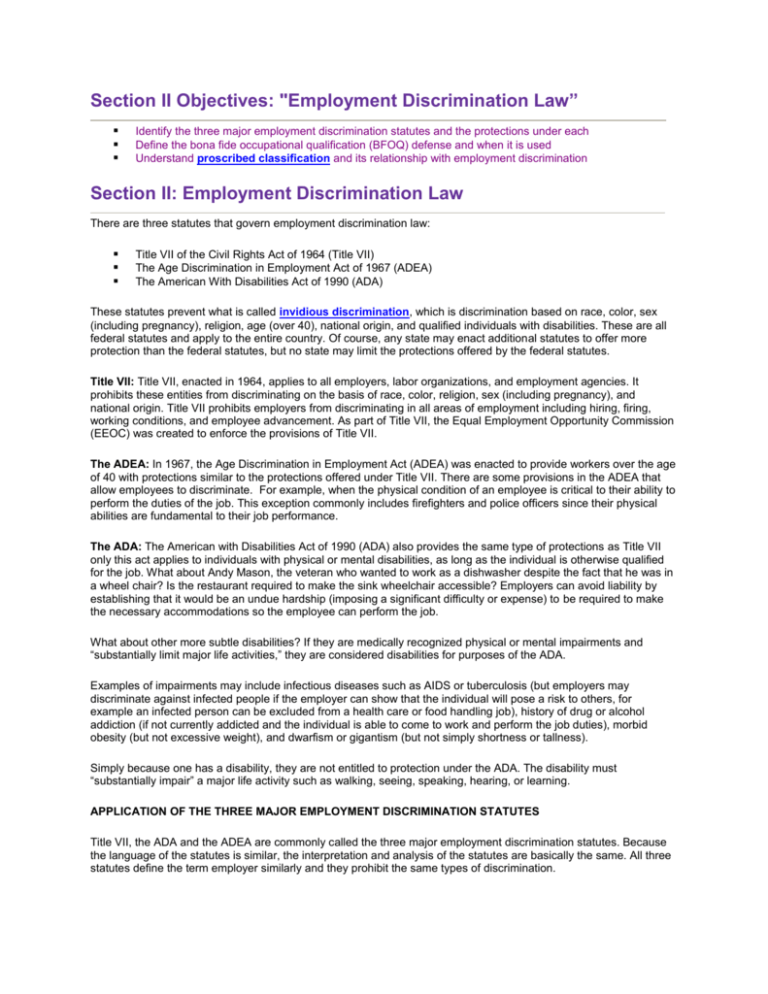
Section II Objectives: "Employment Discrimination Law” Identify the three major employment discrimination statutes and the protections under each Define the bona fide occupational qualification (BFOQ) defense and when it is used Understand proscribed classification and its relationship with employment discrimination Section II: Employment Discrimination Law There are three statutes that govern employment discrimination law: Title VII of the Civil Rights Act of 1964 (Title VII) The Age Discrimination in Employment Act of 1967 (ADEA) The American With Disabilities Act of 1990 (ADA) These statutes prevent what is called invidious discrimination, which is discrimination based on race, color, sex (including pregnancy), religion, age (over 40), national origin, and qualified individuals with disabilities. These are all federal statutes and apply to the entire country. Of course, any state may enact additional statutes to offer more protection than the federal statutes, but no state may limit the protections offered by the federal statutes. Title VII: Title VII, enacted in 1964, applies to all employers, labor organizations, and employment agencies. It prohibits these entities from discriminating on the basis of race, color, religion, sex (including pregnancy), and national origin. Title VII prohibits employers from discriminating in all areas of employment including hiring, firing, working conditions, and employee advancement. As part of Title VII, the Equal Employment Opportunity Commission (EEOC) was created to enforce the provisions of Title VII. The ADEA: In 1967, the Age Discrimination in Employment Act (ADEA) was enacted to provide workers over the age of 40 with protections similar to the protections offered under Title VII. There are some provisions in the ADEA that allow employees to discriminate. For example, when the physical condition of an employee is critical to their ability to perform the duties of the job. This exception commonly includes firefighters and police officers since their physical abilities are fundamental to their job performance. The ADA: The American with Disabilities Act of 1990 (ADA) also provides the same type of protections as Title VII only this act applies to individuals with physical or mental disabilities, as long as the individual is otherwise qualified for the job. What about Andy Mason, the veteran who wanted to work as a dishwasher despite the fact that he was in a wheel chair? Is the restaurant required to make the sink wheelchair accessible? Employers can avoid liability by establishing that it would be an undue hardship (imposing a significant difficulty or expense) to be required to make the necessary accommodations so the employee can perform the job. What about other more subtle disabilities? If they are medically recognized physical or mental impairments and “substantially limit major life activities,” they are considered disabilities for purposes of the ADA. Examples of impairments may include infectious diseases such as AIDS or tuberculosis (but employers may discriminate against infected people if the employer can show that the individual will pose a risk to others, for example an infected person can be excluded from a health care or food handling job), history of drug or alcohol addiction (if not currently addicted and the individual is able to come to work and perform the job duties), morbid obesity (but not excessive weight), and dwarfism or gigantism (but not simply shortness or tallness). Simply because one has a disability, they are not entitled to protection under the ADA. The disability must “substantially impair” a major life activity such as walking, seeing, speaking, hearing, or learning. APPLICATION OF THE THREE MAJOR EMPLOYMENT DISCRIMINATION STATUTES Title VII, the ADA and the ADEA are commonly called the three major employment discrimination statutes. Because the language of the statutes is similar, the interpretation and analysis of the statutes are basically the same. All three statutes define the term employer similarly and they prohibit the same types of discrimination. An employer for purposes of Title VII and the ADA is defined as an entity having fifteen or more employees. For purposes of the ADEA, an employer is an entity with twenty or more employees. The types of discrimination include any actions taken by the employer that is based on a distinction called a proscribed classification. Proscribed classifications include those classifications defined by the various statutes. For example, if an employer specifically refuses to hire a woman for a certain job, the employer is said to have made an employment decision based upon utilizing a proscribed classification (sex) under the statute. When Nickoai refused to hire Zach because he was African American, he made an employment decision based on a proscribed classification, his race, and therefore Nickolai violated Title VII. Did Costa’s Restaurant illegally discriminate against Shelly for being overweight? No, not unless she was morbidly obese, and therefore protected under the ADA. THE BONA FIDE OCCUPATIONAL QUALIFICATION DEFENSE (BFOQ) Even under the statutes, there are certain situations in which “religion, sex, or national origin is a bona fide occupational qualification reasonably necessary to the normal operation of that particular business or enterprise.” 42 U.S.C.A. 2000e-2(e). This is called a bona fide occupational qualification (BFOQ). An employer accused of discrimination may therefore raise the defense that there is a justification for discriminating against the complainant. The employer then has the burden of proving what justification exists for their discriminatory behavior. Note: there is no BFOQ defense available when the discrimination is based on race. In a BFOQ defense, the employer must demonstrate that there is a reasonable basis to conclude that all or substantially all of those people whom they refused to hire were unable to perform the functions necessary for the job. If the employer succeeds in proving that they had a justifiable reason not to hire members of a proscribed class, the employer will be allowed to legally discriminate against those class members. What does this mean? Here are some examples: In 1971, an airline tried to convince the court that it was a bona fide occupational qualification for all airline attendants to be female. The airline argued unsuccessfully that female flight attendants provided a more “soothing atmosphere” than male attendants. The court held that the purpose of having flight attendants onboard airliners was to assure passenger safety, not to “soothe” passengers. The discrimination based upon sex was therefore not a justifiable BFOQ for airline attendants. Next, the airline argued that customers preferred women to men as airline attendants. Therefore, it argued, being female was a bond fide occupational qualification for the job of airline attendant. The court held that denying males the opportunity to work as flight attendants would undermine the exact purpose for which the statute was enacted. The court specifically held that customer preference in this situation did not substantiate a BFOQ defense. Diaz v. Pan Am. World Airways Inc (1971) There are, however, situations in which courts have held that customer preference is a justifiable BFOQ defense. In Fesel v. Masonic Home of Delaware (1978) a patient argued that for modesty reasons, intimate personal care should be performed by a person of the same sex as the patient. The court held that this “customer preference” could be a BFOQ. The Masonic Home could legally discriminate (based on the employee’s sex) when hiring employees for this position. Similarly, the court found that female inmates who have suffered abuse at the hands of men would be better served by having female counselors. Therefore it was a BFOQ for the counselors to be female and the Department of Health could legally discriminate against males when hiring counselors for these positions. Torres v. Wisconsin Department of Health and Social Services (1988) Other BFOQ defenses that have been upheld by courts include the requirement that exotic dancers in a strip club must be women and that an actor for a male part must be a male and an actor for a female part must be a female. In the case of the dancer or actor, the BFOQ was deemed reasonable since the sex of the employee (actor or dancer) is fundamental to what was being sold. In the case of the actor, the dramatic experience was what is being sold, and in order for a customer to experience the drama, it was reasonable to have males play the part of males and vice versa. Likewise, in the case of the exotic dancer the experience of watching a female dance is what is being sold to the customer. Sex can only be a BFOQ when it is clearly fundamental to the experience that is being sold. The sex of a server in a restaurant is not a BFOQ so a restaurant may not discriminate based on sex when hiring servers. However, if what is being sold is the experience of eating in an establishment of a certain ethnicity, the requirement that servers be of that ethnicity may be a BFOQ. The fact that an employee becomes pregnant may or may not allow an employer to limit their employment depending on the job being performed by the pregnant employee. For example pregnant airline attendants may place passengers at risk due to physical limitations. Therefore airlines may discriminate based on sex in this limited circumstance. Section II Question and Answers 1. What three statutes govern employment discrimination law? 2. Who and what rights does each employment statute protect? 3. What is the definition of employer under the three employment discrimination statutes? 4. What is proscribed classification? 5. What are some examples in the text of cases in which courts found discrimination on the basis of proscribed classifications? 6. What is the bona fide occupational qualification defense (BFOQ)? 7. In what situation can a BFOQ not be used?

